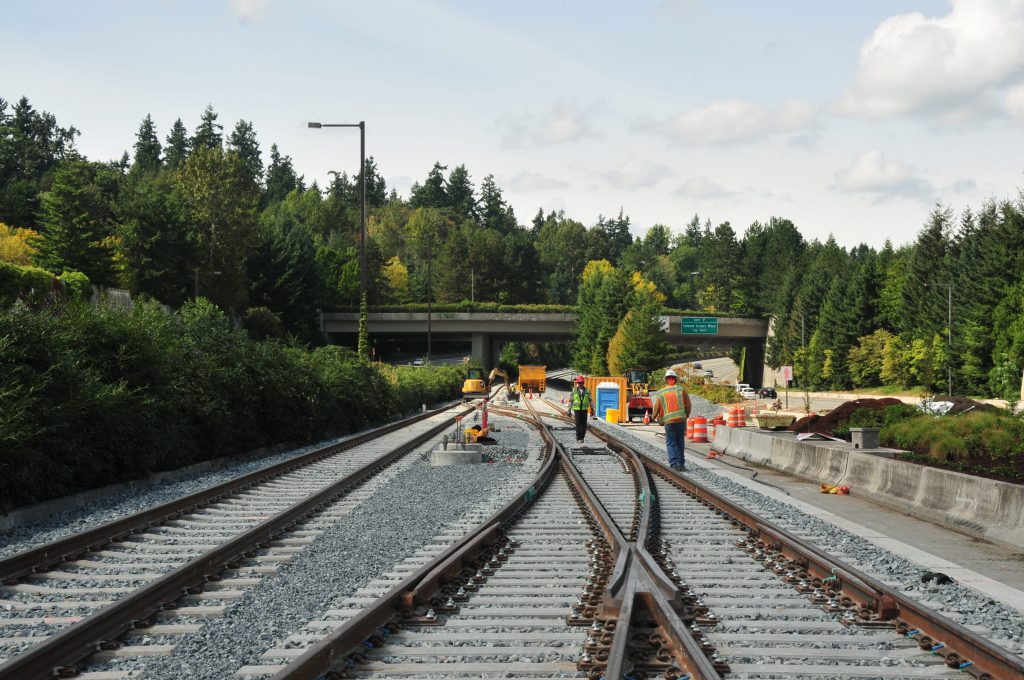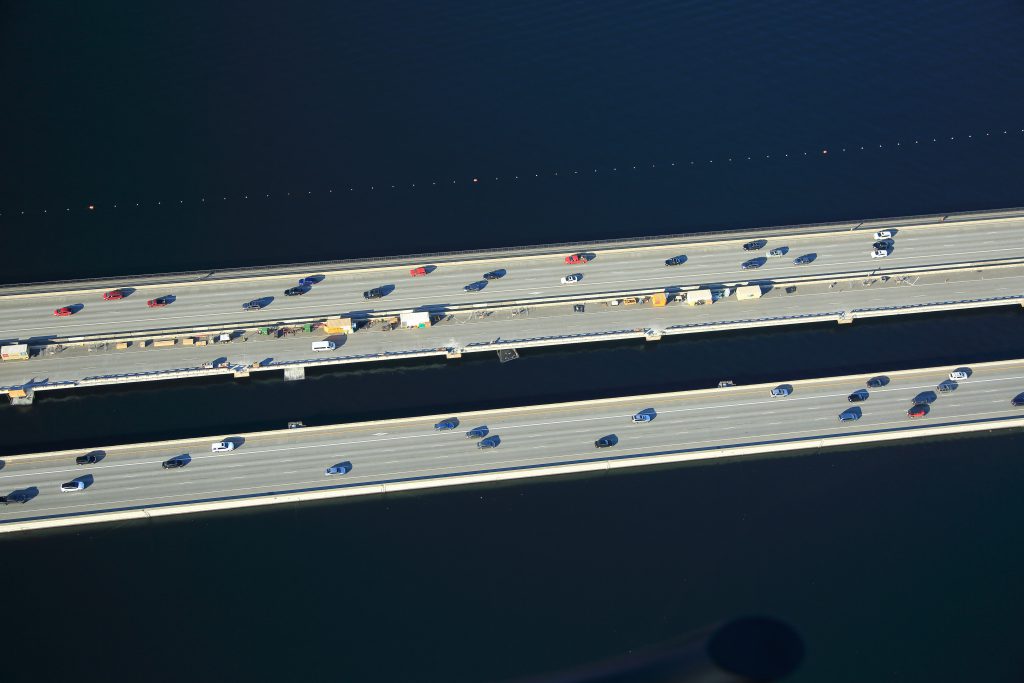A Kiewit joint venture is creating a new set of firsts on a bridge originally conceived by a pioneering Seattle bridge engineer.
In the early 1920s, an engineer named Homer More Hadley was something of a maverick.
He envisioned a new roadway for landlocked Seattle-area drivers in the eastern part of the city: a floating bridge to span Lake Washington.
It was an innovative solution for a structure that needed to work with the up-to-200-foot lake depth, too deep for traditional pilings or towers.
The engineer’s concept, inspired by European cellular construction and designed as a series of hollow concrete barges, was initially ridiculed by naysayers who called it “Hadley’s Folly.”
But after intensive lobbying by fans of the idea, his dream came to life. That bridge, named for Lacey V. Murrow, second director of the Washington State Highway Department, opened to traffic in 1940.
In 1989, nearly a half-century later, Hadley got a posthumous tribute: the Homer M. Hadley Memorial Bridge, a companion floating bridge to carry the westbound lanes of I-90 between Mercer Island and Seattle.
A joint venture marked by firsts
Today, the Homer M. Hadley (HMH) Memorial Bridge is making news of its own. In 2023, the structure will be the first-ever floating bridge to carry light rail traffic (LRT).
The bridge, approximately 6,000 feet long, is the centerpiece of joint venture Kiewit Hoffman East Link Constructors for Sound Transit, in partnership with the Washington State Department of Transportation (WSDOT).
The LRT project — which is marked by some impressive firsts for the team — encompasses a 7-mile stretch of roadway.
It intersects with Sound Transit’s north-south mainline, running from the International District/Chinatown Station in the downtown Seattle Transit Tunnel to south Bellevue at the east end of the East Channel Bridge.
Work has included closing the existing high-occupancy vehicle (carpool) lanes, retrofits for the bridge and two tunnels, installation of the new guideway, and building two stations. Before those tasks could begin, there were also seismic upgrades to the HMH Bridge and three others in the area.

Tight spaces
To strengthen the existing structure for the increased load brought by the light rail trains and associated infrastructure, the team installed post-tensioning strands inside the bridge. At 3,600 feet, they will be the longest continuous tendons in the world.
The meticulous process required crews to work inside the individual cells of the bridge, core drilling roughly 2,500 holes below the water line to create a path for the continuous tendons and the ducts that encase them.
This wasn’t a job for even the mildly claustrophobic or non-limber individual.
“You’re doing everything in a 30-by-15-by-15-foot cell,” said Brawn Lausen, project manager, “so you’re bringing the materials inside through a little door, a hatch, that’s two-feet-by-four-feet wide.”
Another challenge: To stay on schedule, the work had to take place while the bridge was open to vehicle traffic.
“While live traffic was traveling above our heads, in many cases we had several workers down below inside the bridge drilling all these holes, putting in the ducts and threading all the post-tensioning strand through it,” said Construction Manager Dave Bowman.
Stretching the strands
The post-tensioning elements were assembled over several months.
“While we were doing all that,” Bowman said, “we worked with Sound Transit and WSDOT to identify a weekend six months in advance when we could do a complete shutdown of the bridge” for the post-tensioning event.
Two massive 600-ton hydraulic rams were lowered down inside the bridge structure.
Several trolley systems took them down to newly constructed large steel anchor frames at the east and west ends of the bridge.
Slowly and methodically, the rams began to stretch the strands until they achieved an elongation of just over 22 lineal feet.
The team’s success earned them the 2019 Award of Excellence for Repair/Rehab/Strengthening by the Post Tensioning Institute.
When the LRT project opens in 2023, the 105-foot-wide top deck of the bridge will allow for a pedestrian path, four lanes of vehicle traffic and two directions of light rail track, eastbound and westbound. The westbound track will be complete by summer 2020.
Sticking to a unique track
Building the guideway that the LRT will run on represents another unique aspect of the project. Typical direct fixation track uses a “drill-and-dowel” method to connect to the existing structure.
The HMH Bridge, however, required another solution because of the existing post-tensioning within the bridge deck. Sound Transit worked with designers for almost a decade to solve that problem.
In an industry first for a floating bridge, 7,400 lightweight precast plinth blocks each weighing 100 pounds were epoxied to the bridge’s pontoon deck, said Project Engineer Mitch Chicha.
In a temperature-controlled environment, a layer of rubberized elastomeric grout was installed to the bottom of every block to prevent the block from cracking as the deck epoxy cured and created heat. That will also allow for resilience in the blocks as trains travel over them.
The bridge surface was prepared and grout dams were formed around each block using angle iron forms. Self-leveling epoxy grout was then installed under the blocks and air pockets removed to ensure a strong bond.
‘A phenomenal feeling’
The project is about 80 percent complete, with track work scheduled for the rest of this year.
By the time work wraps at the end of 2020, staff and craft will have invested 1 million man-hours. The team will then turn over the project to Kiewit subsidiary, Mass. Electric Construction Co., to install the infrastructure to power the trains.
Chicha says he’ll look back with pride on the innovation the project represents.
“It’s really easy to get wrapped up in the job and forget that some of the work that we’re performing out here has never been done before,” he said. “It’s a phenomenal feeling to be involved in these industry firsts.”

![The view circa 1959 looking west from the original Lacey V. Murrow Memorial Bridge, which carried eastbound and westbound traffic across the lake. [Photo credit: Seattle Municipal Archives via Wikimedia Commons]](https://newsroom.kiewit.com/wp-content/uploads/2020/03/Cars_on_I-90_floating_bridge_1959_28273807086.jpg)


